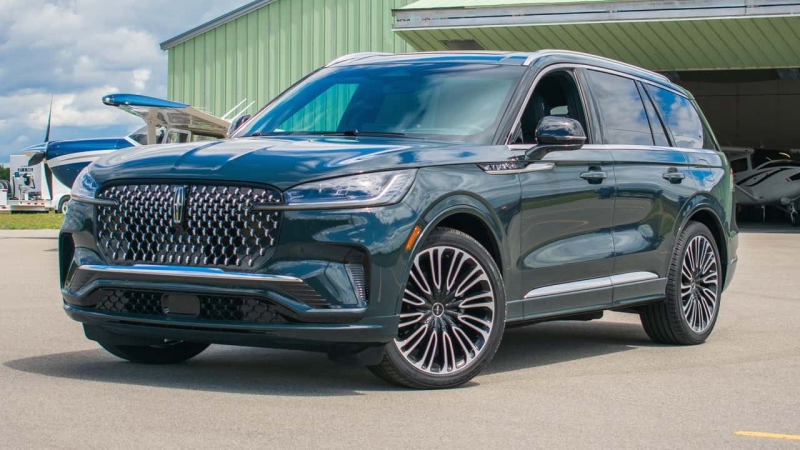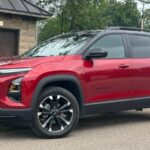A very mild mid-cycle refresh leaves us with an uglier face, a dated interior, and the Ford Explorer’s personality.
Christopher Smith / Motor1
It’s hard to believe the Lincoln Aviator is already five years old. Credit the SUV’s handsome styling and posh interior, which really turned heads back in the day. Having almost 500 horsepower didn’t hurt, either, but much has changed in the world since then. You know what hasn’t changed much? The Lincoln Aviator.
While the Aviator receives a minor mid-cycle refresh for 2025, these updates aren’t nearly enough. Moreover, some of the changes feel like a step backward. And there’s still no high-output hybrid powertrain in sight after it was dropped in 2023. All in all, the updated Aviator does little to differentiate itself from its Ford Explorer vibes and asks a lot of buyers with its $91,575 as-tested price. And that’s not even the Aviator’s priciest spec.
| Quick Specs | 2025 Lincoln Aviator Black Label AWD |
| Engine | Twin-Turbocharged 3.0-Liter V-6 |
| Output | 400 Horsepower / 415 Pound-Feet |
| Efficiency | 17 City / 25 Highway / 20 Combined |
| Base Price / As Tested | $60,475 / $91,575 |
Let’s do a quick review of what’s changed for 2025, starting with the Aviator’s face. The grille is larger, and by a hefty margin. It’s still rectangular, but it dips further down, meeting a redesigned lower fascia. Vertically oriented corner vents replace the simple horizontal vents and running lights of the outgoing model, and up top, the headlights are smaller.
These changes produce a design less proportional and satisfying than it once was. Frankly, the 2025 Aviator is a set of split headlights away from looking like a BMW X7. This is an unfortunate consequence of sharing its chassis with the Ford Explorer, which also got a similar facelift for 2025. Sadly, there’s too much similarity between them for me to not see the Explorer’s gaping mouth when looking at the Lincoln.
This isn’t the only time I’ll toss a penalty flag for the Aviator’s too-close connection with the Explorer. Fortunately, the Lincoln remains as elegant in profile as ever, and the exterior tweaks—while a step backward in my opinion—aren’t a deal breaker. There’s still plenty of curb appeal here.
Changes to the interior are centered around a new 13.2-inch touchscreen. If that sounds familiar… yup you guessed it. The new Explorer has the same screen with the same Google Assistant tech and the same layout for its plethora of features. Admittedly I’m not a huge fan of Ford’s current infotainment systems, I find them a bit too complicated for simple tasks like adjusting temperature controls. Add extra components like massaging seats to the mix and interacting with the screen becomes even more distracting. However, it’s a system you can get used to without much difficulty, so again, not a deal breaker.
As with so many touchscreens, this Lincoln’s is mounted tablet-style on the dash. It’s a dated design trend that needs to disappear. A redesigned dash that combines the driver and center displays into a single screen is sorely needed here. At the very least, an integrated in-dash infotainment screen would distinguish the near-six-figure Lincoln from a $40,000 Explorer Active. The Mercedes-Benz GLE-Class has it. The BMW X5 has it. Audi has it. Genesis. The list goes on.
I’m not saying the Aviator’s interior is low-rent. The wood trim looks nice, and though I don’t really understand the weird square patterns scattered around the interior, they are a neat touch. The leather is soft, the seats sublime, and I’m always a sucker for a big ol’ power-operated moonroof. But the abundance of black trim looks and feels cheap. The chrome trim ends up feeling tacky as a result. And you may as well just fold the third-row seat and leave it there. Unless you’re regularly trucking around small kids, nobody will want to sit in the back.
At least the Lincoln is supremely comfortable. The active suspension with Air Glide is blissful over rough roads, delivering a ride that’s decidedly soft but not overly isolated. Honestly, I never noticed it doing anything dramatic in any of the drive modes, and I consider that a plus in this context. The Aviator isn’t a hot rod Lincoln and nobody is going to treat it as such. Even if drivers dip into the 400-horsepower twin-turbocharged 3.0-liter V-6—still the only engine option—a pleasant rush of acceleration is all you’ll get.
You’ll get reasonable fuel economy, too. EPA ratings list the Aviator at 17 city, 25 highway, and 20 combined. At 75 miles per hour on the highway, I bounced between 23 and 25 mpg, but running a bit slower on rural roads got me to 27. Can you do better in the 400-horsepower range? Yes, but not by much. And you won’t be taking 150-mile hands-free trips with BlueCruise in those competitors. Ford’s advanced Level 2 system is arguably the best in the business, and it’s standard equipment on the Black Label.
But even cruising on quiet highways where a luxury vehicle should shine, there are frustrating examples of cost-cutting. The wind and road noise is excessive, and the growl from the V-6 is loud under even modest throttle. I get the impression this powertrain is a direct swap from Ford with barely any refinement for the luxury brand. And then there are little things like non-adjustable second-row seatbelts, cutting uncomfortably across the necks of children and short adults. Really, Lincoln?
A few weeks prior to my long weekend with the Lincoln, I spent a day driving the 2025 Explorer. I really wanted to embrace the Aviator; even with the refreshed face, I think it’s among the sharpest-looking mid-size SUVs on the market. But instead, I found it was really just a Ford Explorer wearing an expensive suit. Sharing platforms certainly isn’t new in the automotive world, all automakers do it to some degree. But this feels like the old days of badge engineering—minimum effort in hopes of maximum profit.
For what it’s worth, I still think the Aviator looks good. It just needs a good personality to match.
Gallery: 2025 Lincoln Aviator Black Label Review
Christopher Smith / Motor1
Competitors:
- Audi Q7
- BMW X5
- Cadillac XT6
- Genesis GV80
- Mercedes-Benz GLE-Class
- Volvo XC90
Get the best news, reviews, columns, and more delivered straight to your inbox, daily. Sign up For more information, read our
Privacy Policy and Terms of Use.
Engine Twin-Turbocharged 3.0-LIter V-6
Output 400 Horsepower / 415 Pound-Feet
Transmission 10-Speed Automatic
Drive Type All-Wheel Drive
Seating Capacity 7
Weight 4,745 – 4,862 Pounds
Towing 5,000 Pounds
Efficiency 17 City / 25 Highway / 20 Combined
Cargo Volume 18.3 / 41.8 / 77.7 Cubic Feet
Base Price $60,475
As-Tested Price $91,575
On Sale Now



